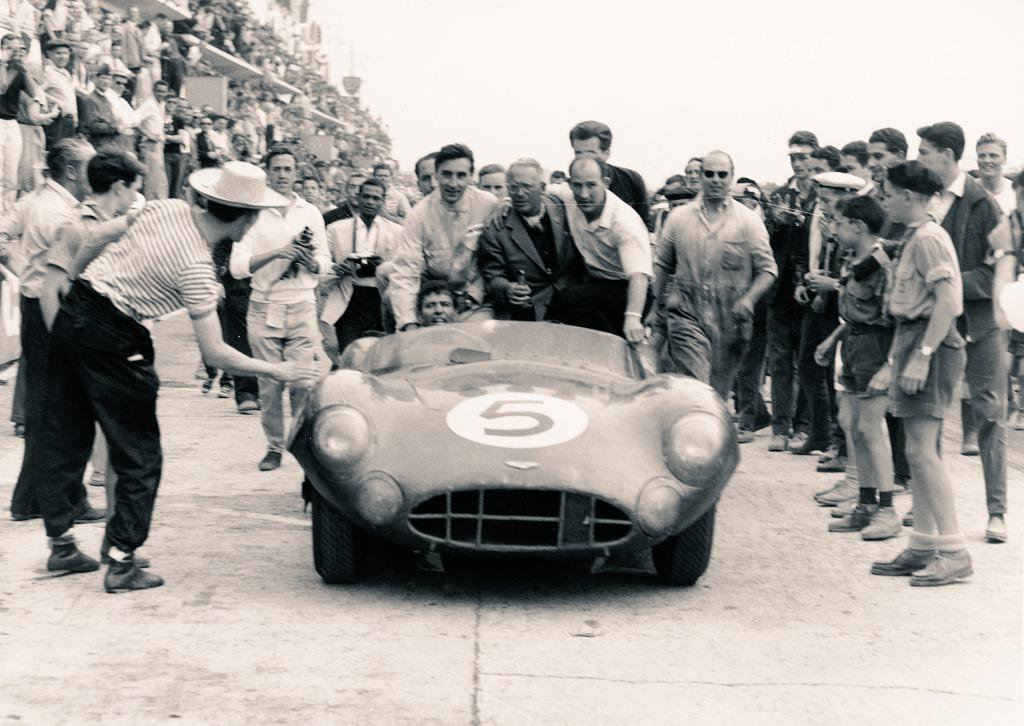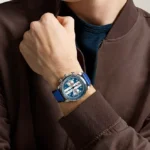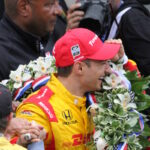TGR Staff
Carroll Shelby has a deep bond with Aston Martin thanks to his racing victories for the factory team in the 1950s. Less well know is his strong connection to fellow Texan and Aston dealer, Sonny Morgan.
Managing principal at John Eagle European, Sonny has known Carroll for many years. They have both attended various events and shows across the Lone Star State.
Sonny also owns a 1966 Shelby Mustang signed by Carroll. The automotive legend signed the pony car after Morgan gave him a demonstration drive in a V8 Vantage. He then turned the wheel over to the English born Cleo Shelby at Carroll’s request. She thoroughly enjoyed driving the fantastic Aston Martin.
During the Sebring race weekend, Carroll was interviewed by Aston Martin about his role in the company’s motorsport history. As many know, the American automotive legend was part of the 1959 Le Mans-winning line-up, as well as at Sebring and also a Formula 1 try for the factory team.
According to Aston Martin Racing, Carroll said:
“It’s always made me very proud to be associated with Aston Martin,” says Carroll Shelby, who is now enjoying retirement. “What we achieved back then was remarkable; particularly as we didn’t have huge resources to spend. I think the Le Mans win in particular really put the company on the map in America.”
Shelby also drove an Aston Martin DBR1 in the 1959 12 Hours of Sebring, with his Le Mans-winning partner Roy Salvadori but sadly the duo were not quite able to repeat their French success. In total, Shelby contested Sebring four times for Aston Martin between 1954 and 1959, making him the company’s most enduring American hero.
Aston Martin first raced at Sebring in 1950 with the DB2, and the company has been represented at the classic American endurance race 11 times in total. The team came tantalizingly close to winning in 1953 when the DB3 of Reg Parnell and George Abecassis was classified second – but the real champagne moment came many years later in 2005.
One of the high points of Aston Martin Racing’s history in America was the 12 Hours of Sebring five years ago: the race debut for the new DBR9, which resulted in GT1 class victory for David Brabham, Stephane Ortelli and Darren Turner, coupled with a tremendous fourth overall.
In 1954 and 1956 Shelby drove the DB3S, before switching to the famous DBR1 for the 1958 and 1959 races. Now aged 87, he still remembers exactly what it was like…
“Sebring is where my whole story with Aston Martin, which would take us all the way to winning Le Mans and the World Championship in 1959, originally started. Back in 1954 I was racing an Allard at a 1000-kilometer race in Argentina, and there I met John Wyer; who was Aston Martin’s team manager at the time. We got talking and agreed that I would drive for Aston Martin at Sebring in the same year.
From then on I stayed loyal to Aston Martin, as it was such a special team. I had offers from many other teams, like Ferrari, but I always chose to stay at Aston Martin because I had a very good and straightforward relationship with everyone there, such as John Wyer, Tony Brooks and Roy Salvadori. In most other teams there was a lot of politics, but Aston Martin was always very fair.
The funny thing was that we never had much luck at Sebring. We were first in class and fourth overall in 1956 in a DB3S that I shared with Salvadori and that was about as good as it got. One year, I remember we were running in third or fourth and when I went to downshift, the entire gear lever came off in my hand! I got the car stopped somehow, but it wasn’t a pretty moment.
Even though we didn’t get the results that we hoped for, Sebring is the race that really launched my international career with Aston Martin and I’ll always be thankful for that.
Back then, of course, the racing at Sebring was completely different: it was all about saving the car for a big push in the last hour. You had to use your judgment constantly and drive to pre-determined lap times in order to be sure of making it through the race. Now the cars are so strong that they can race all the way to the end, but back in my day, there weren’t enough brakes on the car for half an hour if you drove flat-out, never mind 12 hours.
While the cars have changed beyond recognition, the Sebring circuit is basically the same. I remember it as a rough and bumpy old airfield, which is still how it is now.
During the race, we used to do stints of around two and a half hours, with around 125-130 degrees Fahrenheit in the cockpit, and we’d actually drill a hole in the seat to let the sweat out. You could lose around 15 pounds in sweat. These days, I believe that the drivers have air conditioning and just need to push a button to change gear!
I’d like to wish them all the very best of luck this weekend, and I’m so proud to see Aston Martin racing in America again. I’m sure that they will love the experience.”
[Source: Aston Martin of Austin Image Via]



















